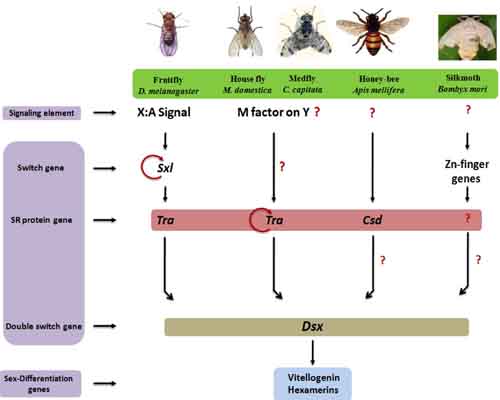|
|
|
| Home » Molecular Genetics » Research |
| Molecular Genetics |
| Sex determination mechanism in animals
|
Unlike Drosophila, mouse and humans, the females of silkworm species are heterogametic with the chromosomal make-up being ZZ in males and ZW in females. The current hypothesis is that the presence or absence of a strong W-linked epistatic factor determines the sex of the organism. This is based on the fact that even in polyploids where there is a single W and several Z chromosomes, the resulting sex would be female. With the mechanism being established in Drosophila, Caenorhabditis elegans and mammals almost to completion, a comparative analysis is made possible.
In the silkworm, males are known to produce more silk compared to the females, where a great proportion of the resources is channeled towards the production of ova. It would be advantageous if the sex ratio could be manipulated so that only males are produced. Also, silkworm belongs to the order Lepidoptera that also includes several devastating pests. To name a few, cotton bollworm, tobacco hornworm etc., cause annually several billion dollars worth of crop loss, world over. Besides, a huge quantity of pesticides is required for the control of the pests. Knowledge about the sex determination mechanism in the silkworm would help devising methods to control these pests, again by the manipulation of the sex ratio.
Some of the genes that are identified and characterized in the fruitfly- Drosophila, the nematode- C. elegans, and mouse are shown to have homologues in humans or found to share conserved domains with human genes. This very fact makes the study significant and important in studying the evolution of sex determination mechanisms. Thus the study being pursued has relevance in strong basic research with potential applications.
|
 |
The players of the sex-determination cascade in the model insect species of Diptera (D. melanogaster, M. domestica, C. capitata and L. cuprina), Hymenoptera (A. mellifera, N. vitripennis) and Lepidoptera (B. mori, A. assama and A. mylitta). (Shukla and Nagaraju, 2010, J. Genetics)
Further reading
Arunkumar KP and Nagaraju J (2011) Drosophila intersex orthologue in the silkworm, Bombyx mori and related species. Genetica 139:141-147.
|
|
| Last updated on: Friday, 21th Nov, 2014. |
|
|
|
|